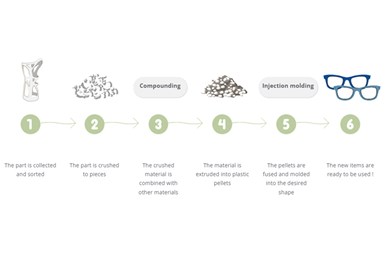Sculpteo Offers RE-cycleo 3D Printed Part Recycling Program
The program offers recycling services to Sculpteo clients not only for the clients’ obsolete parts but also for production scrap.
Sculpteo’s RE-cyleo program enables its clients to recycle obsolete parts starting from the very first unit, giving the parts a second life and contributing to the development of a more sustainable sector. The program includes parts printed with Nylon PA12 and Nylon PA11.
According to the company, the recycled material will be used in the plastics industry and give a second life to the old parts that can be recycled as many times as possible. With this initiative, Sculpteo says it becomes one of the first 3D printing services to offer its clients recycling services not only for clients’ parts but also for production scrap.
Sculpteo says the recycling program is part of its commitment to more sustainable printing. As businesses move toward a better understanding of environmental issues, it has become urgent that industries like 3D printing pave the way for more sustainable solutions, the company says.
Being concerned about the environmental impact of its activity, Sculpteo has worked to make it possible to recycle its clients’ Nylon PA11 and Nylon PA12 obsolete parts. It is said 3D printing presents certain advantages compared to other plastic manufacturing processes (local on-demand production, very low material loss and more). In this continuity, Sculpteo is expanding its line of sustainable materials such as biosourced Nylon PA11. The company continues its research to make 3D printing even more sustainable and presents an interesting initiative through this program.
“With RE-cycleo, we are inaugurating a new, more responsible way of producing, where we offer clients the possibility to upgrade their products,” says Alexandre d’Orsetti, Sculpteo CEO. “It has taken decades for mass industries to develop effective recycling programs with their gigantic volumes. At Sculpteo, we can offer it from the first part.”
The recycling process entails clients sending obsolete parts to Sculpteo along with a destruction authorization. Once received, the first step of the process entails collecting and sorting the parts depending on the material (Nylon PA11 or Nylon PA12). The parts are then placed in octabins that can contain hundreds of kilos of parts. The sorted nylon waste is then crushed into pieces.
To maintain the industrial secrecy and confidentiality of its clients, Sculpteo guarantees that the grinding only happens inside its factory. The crushed material is then sent to Arkema, which will recycle it as part of its Virtucycle program. The grinded material is analyzed to ensure there is no contamination. Next comes the compounding stage where the material is remelted, chilled and cut into pellets that will be used in other industrial applications. These pellets form the final state of the new material which can now be used.
In the case of injection molding, the pellets will be melted and injected into a mold to create a new product such as car components, tennis rackets, shoes, helmets, a suitcase and more. This gives a second life to unused parts or end-of-life parts. The company says this whole process uses 100% renewable energy.
- Listen to this episode of AM Radio in which Dr. Tim Simpson and Stephanie Hendrixson discuss current research and future opportunities on AM Radio.
- Read how another additive manufacturing company is encouraging users to give priority to recycled filaments in the interests of sustainability and resource conservation.
- Here’s another episode of AM Radio. In this program, the AM writers discuss why additive manufacturing is often closely associated with sustainability and how can companies use AM to develop sustainable processes.
Related Content
8 Cool Parts From Formnext 2024: The Cool Parts Show #78
End-use parts found at Formnext this year address various aspects of additive's advance, notably AM winning on cost against established processes.
Read MoreDMG MORI: Build Plate “Pucks” Cut Postprocessing Time by 80%
For spinal implants and other small 3D printed parts made through laser powder bed fusion, separate clampable units resting within the build plate provide for easy transfer to a CNC lathe.
Read More3D Printing with Plastic Pellets – What You Need to Know
A few 3D printers today are capable of working directly with resin pellets for feedstock. That brings extreme flexibility in material options, but also requires greater knowledge of how to best process any given resin. Here’s how FGF machine maker JuggerBot 3D addresses both the printing technology and the process know-how.
Read MoreAdditive Manufacturing Is Subtractive, Too: How CNC Machining Integrates With AM (Includes Video)
For Keselowski Advanced Manufacturing, succeeding with laser powder bed fusion as a production process means developing a machine shop that is responsive to, and moves at the pacing of, metal 3D printing.
Read MoreRead Next
Crushable Lattices: The Lightweight Structures That Will Protect an Interplanetary Payload
NASA uses laser powder bed fusion plus chemical etching to create the lattice forms engineered to keep Mars rocks safe during a crash landing on Earth.
Read MoreBike Manufacturer Uses Additive Manufacturing to Create Lighter, More Complex, Customized Parts
Titanium bike frame manufacturer Hanglun Technology mixes precision casting with 3D printing to create bikes that offer increased speed and reduced turbulence during long-distance rides, offering a smoother, faster and more efficient cycling experience.
Read More3D Printed Polymer EOAT Increases Safety of Cobots
Contract manufacturer Anubis 3D applies polymer 3D printing processes to manufacture cobot tooling that is lightweight, smooth and safer for human interaction.
Read More





















